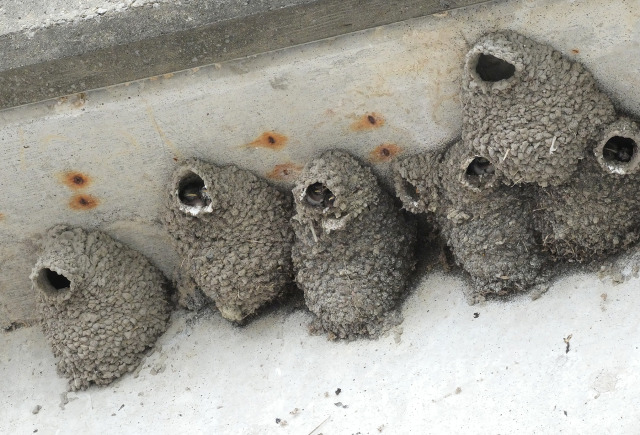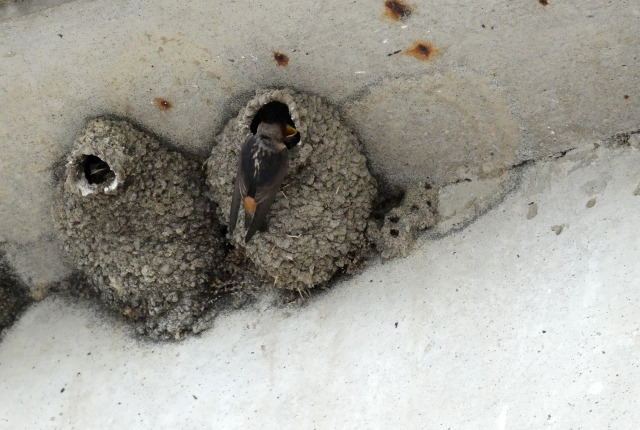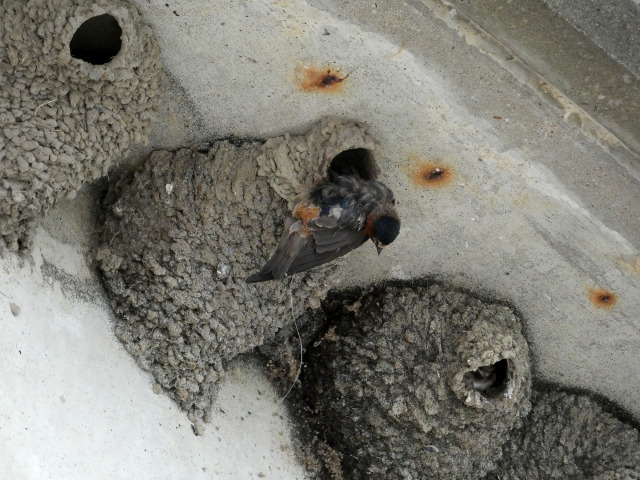by Patrick McShea

Cliff Swallows are potters. The gourd-shaped earthen vessels the birds construct, one tiny mouthful of mud at a time, provide shelter for their eggs and young. In Pennsylvania, and across much of the species’ current continent-wide breeding range, bridges provide favored nest sites for birds whose ancestors, until the early decades of the 1800’s, seem to have been restricted to nesting against low elevation cliffs in western mountain ranges.
The nests pictured above adhere to the concrete supports of a bridge crossing an arm of Lake Arthur in Butler County’s Moraine State Park. During field survey work leading up to the publication of the Second Atlas of Breeding Birds in Pennsylvania in 2012, bridges accounted for 44% of Cliff Swallow nest sites, barns for 33%, and churches, houses, other buildings, and dams for the balance. The species nests in colonies, and the number of nests in bridge-based colonies also far outnumbered those at other sites.
In Birds of Western Pennsylvania, a 1940 publication by W.E. Clyde Todd, then the museum’s Curator of Birds, nest descriptions are a highlight of the Cliff Swallow account.
“The type is retort-shaped, globular, with a neck springing from above and turned to open downward: a beautiful, symmetrical structure. The shape however is modified to suit the space – truncated or extended, as need requires; and where the nests are close-set, the chamber within, though pouch-like, is not truly symmetrical.”
“The nests are built of pellets of mud laid wet and retaining in the finished structure, each its smooth-rounded individuality. The walls speak of cunning and labor and of security, as does a wall of human masonry.”

On a recent early summer morning the Cliff Swallows’ incorporation of our culture’s indispensable highway architecture into their reproductive cycle made for easy and entertaining bird watching. There were hungry young in every chamber of an easily viewed eight-nest cluster. As parent birds returned regularly from insect-catching forays over the nearby lake, the entryways to the dark clay pouches were brightened by the bright yellow gaping beaks of the young.

Appreciation of the beneficial match between people and birds was leavened by a sight at another nest cluster on an adjacent bridge support. When a swallow perched against a nest remained still through several feeding cycles of its neighbors, an inspection with binoculars revealed a tragic circumstance. The bird appeared to have become entangled in, and eventually strangled by discarded fishing line, eight inches of which dangled from the lifeless feathered body.
Patrick McShea works in the Education and Visitor Experience department of Carnegie Museum of Natural History. Museum employees are encouraged to blog about their unique experiences and knowledge gained from working at the museum.
Reference
Second Breeding Bird Atlas of Pennsylvania – http://www.pabirdatlas.psu.edu/
Related Content
Carnegie Museum of Natural History Blog Citation Information
Blog author: McShea, PatrickPublication date: July 6, 2021
